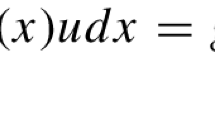Abstract
The Hill differential equation describes the relative motion of a satellite w.r.t. a circular reference orbit. The deviations in the orbit are caused by a residual acceleration, which is small compared to the effect of the central gravitational field. In this paper, the acceleration of a local mass anomaly in the central body is considered, which rotates w.r.t. the inertial frame with a constant angular velocity. The mass anomaly is modeled by a superposition of radial base functions. The potential and the gradient of each base function are represented in the orbit by the Keplerian elements, the rotation rate of the central body and the parameters of the base function, i.e. the position of its center, the shape and a scaling factor. The inhomogeneous solution of the Hill differential equation for short arcs is found by means of the Laplace transform. A few lower orders of the solution require an additional Laplace transform, to consider the so-called resonance cases. The final deviations are described in a closed and differentiable formula of the Keplerian elements and the parameters of the base function.
Similar content being viewed by others
References
Abramowitz, M., Stegun, I.A.: Handbook of Mathematical Functions With Formulas, Graphs, and Mathematical Tables (10th ed.), pp. 1019–1030 (1972)
Antoni, M.: Nichtlineare Optimierung regionaler Gravitationsfeldmodelle aus SST-Daten. PhD thesis, Universität Stuttgart (2012)
Balmino, G., Schrama, E.J.O., Sneeuw, N.: Compatibility of first-order circular orbit perturbations theories; consequences for cross-track inclination functions. J. Geodesy, 70(9), Springer, pp. 554–561 (1996) doi:10.1007/BF00867863
Beutler G.: Methods of Celestial Mechanics (vol. 1). Springer, Berlin (2005)
Doetsch G.: Anleitung zum praktischen Gebrauch der Laplace-Transformation. R. Oldenbourg, München (1956)
Keller, W., Antoni, M., Weigelt, M.: A Closed Solution of the Variational Equations for Short-Arc SST. (2011) http://www.uni-stuttgart.de/gi/research/paper/2009/KellerAntoniWeigelt.pdf
Kim, J.: Simulation Study of A Low-Low Satellite-to-Satellite Tracking Mission. PhD thesis, The University of Texas at Austin, pp. 244–258 (2000)
Kostelec, P.J., Rockmore, D.N.: FFTs on the Rotation Group. (2003) http://www.cs.dartmouth.edu/~geelong/soft/03-11-060.pdf
Meyer, U.: Möglichkeiten und Grenzen der Hill-Gleichungen für die Schwerefeldbestimmungen. PhD thesis, Technische Universität München (2006)
Schrama, E.J.O.: The role of the orbit errors in processing of satellite altimeter data. Publications on Geodesy 33, Delft, ISBN-10: 90 6132 239, pp. 53–69 (1989)
Sneeuw, N.: A Semi-Analytical Approach to Gravity Field Analysis from Satellite Observations. PhD thesis, Technische Universität München (2000)
Tenzer R., Klees R.: The choice of the spherical radial basis functions in local gravity field modeling. Studia Geophysica et Geodaetica 52(3), 287–304 (2008). doi:10.1007/s11200-008-0022-2
Vilenkin N.: Special Functions and the Theory of Group Representation. American Mathematical Society, Providence (1968)
Author information
Authors and Affiliations
Corresponding author
Rights and permissions
About this article
Cite this article
Antoni, M., Keller, W. Closed solution of the Hill differential equation for short arcs and a local mass anomaly in the central body. Celest Mech Dyn Astr 115, 107–121 (2013). https://doi.org/10.1007/s10569-012-9454-7
Received:
Revised:
Accepted:
Published:
Issue Date:
DOI: https://doi.org/10.1007/s10569-012-9454-7




